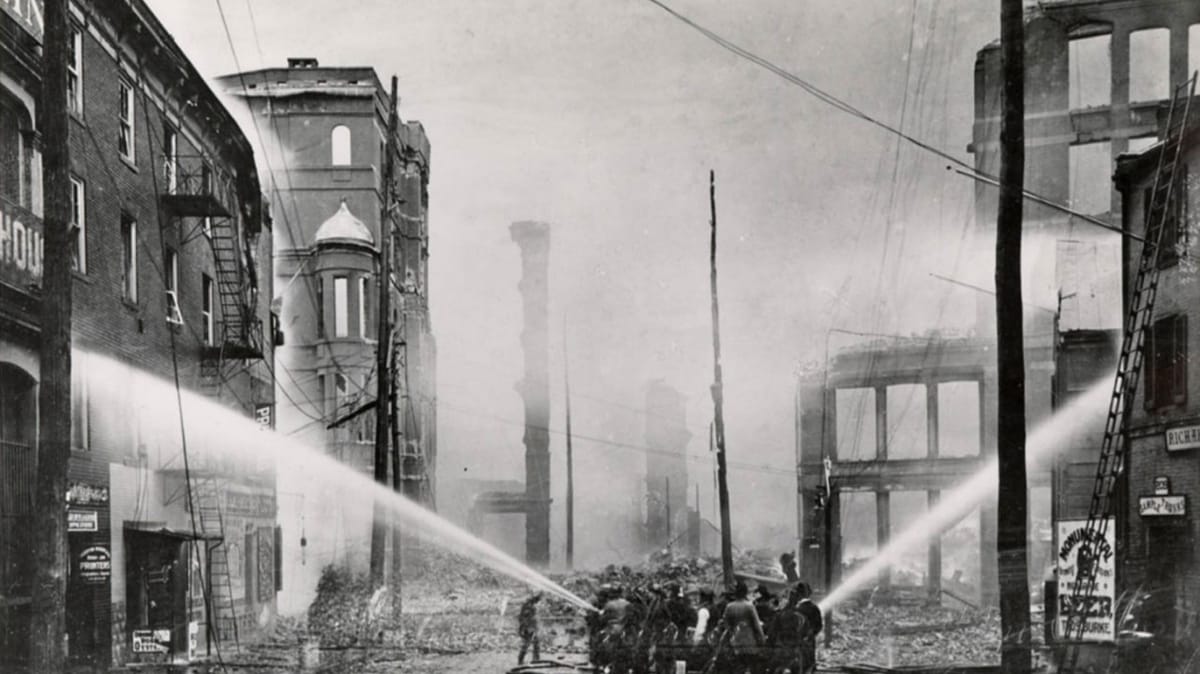What if your hose doesn't fit the hydrant?
A little before eleven in the morning on February 7th, 1904, fire alarms began to sound across Baltimore. For the next thirty hours, the Great Baltimore Fire scorched the city...

A little before eleven in the morning on February 7th, 1904, fire alarms began to sound across Baltimore. For the next thirty hours, the Great Baltimore Fire scorched the city. Fire companies from Philadelphia, Washington, D.C., New York, New Jersey, and Delaware rushed to join in the fight. Unfortunately, many of those firefighters from out of town were unable to use their equipment, because each city’s firefighting systems used a unique coupling system. Thirty-five thousand people were left unemployed, fifteen hundred buildings across 140 acres were destroyed, and the fire trucks, wagons, and hoses from out of town sat useless, unable to connect to Baltimore’s fire hydrants.
Standards are important. They establish common ground so that different units can work together. In the twenty-first century, most of them have faded into the background. We take them for granted, forgetting that every one had to be defined, agreed upon, and most importantly, adopted.
There are standards of form, like the shape and size of hose systems, and standards of measurement. Where standards of form are concrete, “I’m from Philadelphia and my hose needs to connect to this hydrant in Baltimore”, standards of measurement are a matter of perspective. My partner is Canadian, and when we’re getting ready for the day, she’ll ask me about the weather. My interpretation of temperature is based in Fahrenheit, her is in Celsius. But there’s a pretty significant difference between 15°F and 15°C. Different standards, based on different baselines. Did you know Fahrenheit originally determined 0° to be the point where a specific brine solution freezes? Thankfully, temperature is a pretty simple thing to measure, and converting between the two standards is as easy as changing a setting on the Weather app.

Measuring social impact is a bit more complicated than reading a thermometer. Every organization has their nuances, their own specific solutions and focal points. That breadth of perspective means that standards are both crucial and remarkably challenging to adopt. For an organization to aggregate their impact across projects, for an intermediary to collect their partner organizations’ work, for a government to track progress across a country, universal goals and clear, common indicators are mandatory.
That’s why b.world projects and indicators can now be aligned with both the United Nations’ Sustainable Development Goals and the Global Impact Investing Network’s IRIS+ standard. These are two of the most comprehensive standard libraries in the sector. Now b.world users can align their organizations’ work with global frameworks covering dozens of major social impact goals, from the alleviation of poverty to the eradication of malaria. Alignment is quick and easy: just click the Align button and select the relevant indicator or goal from the subsequent list!

Users could already align with the SDGs, and adding IRIS+ is an exciting new step, but that’s not all that we’ve done. Behind the scenes, we’ve created a new model for library alignment with b.world Projects and Logframes, so more libraries can be easily added in the future. As needs arise and new standards are established for specific areas of impact, we’ll be able to add them quickly and easily. Have a standards library you’d like to see added to b.world? Reach out!

Collaboration and community are critical for lasting impact, and working atop standards enables such connectivity. At the start of the Second World War, each of the Allied forces used different dimensions for ammunition and aircraft parts. Even screws were threaded differently. “‘We can’t borrow parts from the British,’ one U.S. mechanic complained, ‘We can’t even steal them. They don’t fit.’” Rapid development, integration, and adoption of standards not only fueled the war effort, they established a new baseline for precision across the globe.
The greatest efforts in human history have been facilitated by this fundamental sort of common ground, and the challenges of our age must be faced in the same way. From human rights to climate change, the seemingly insurmountable complexities of mammoth issues can be reduced, if not entirely resolved, thanks to standards. Once something can be understood and measured, it can be addressed.
Start aligning your organization’s work to the SDGs or IRIS+ today on b.world!





